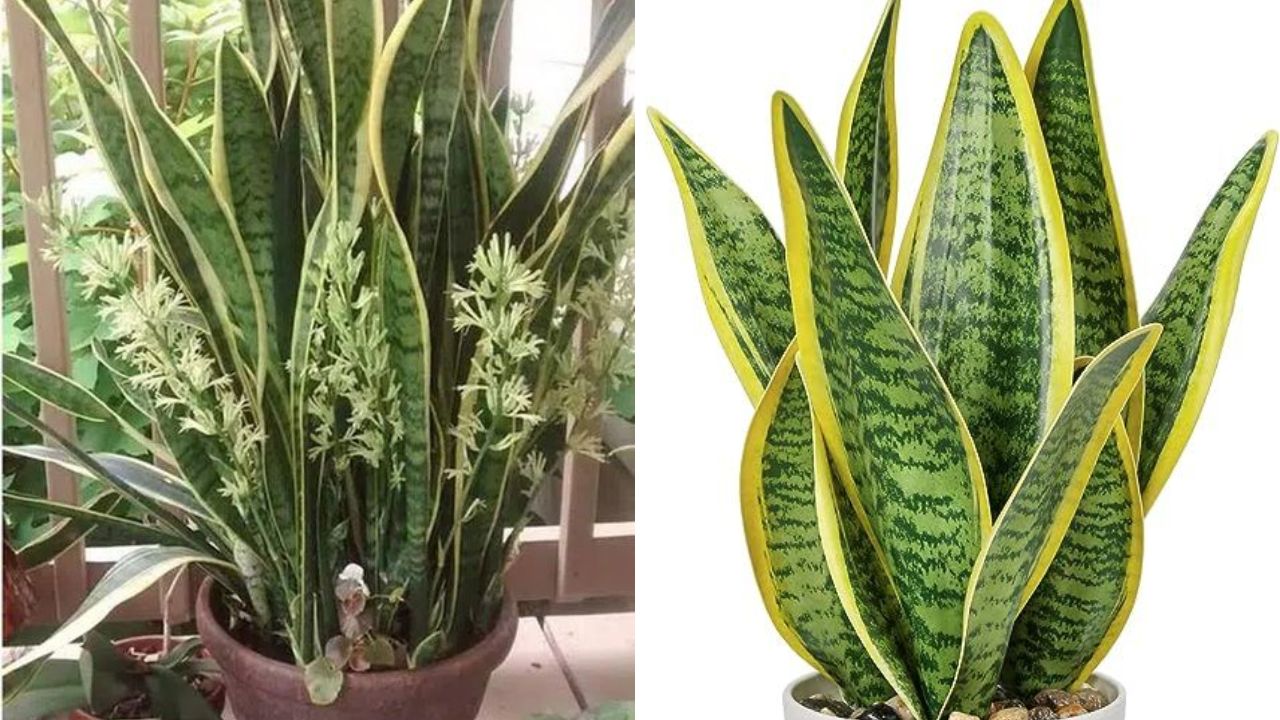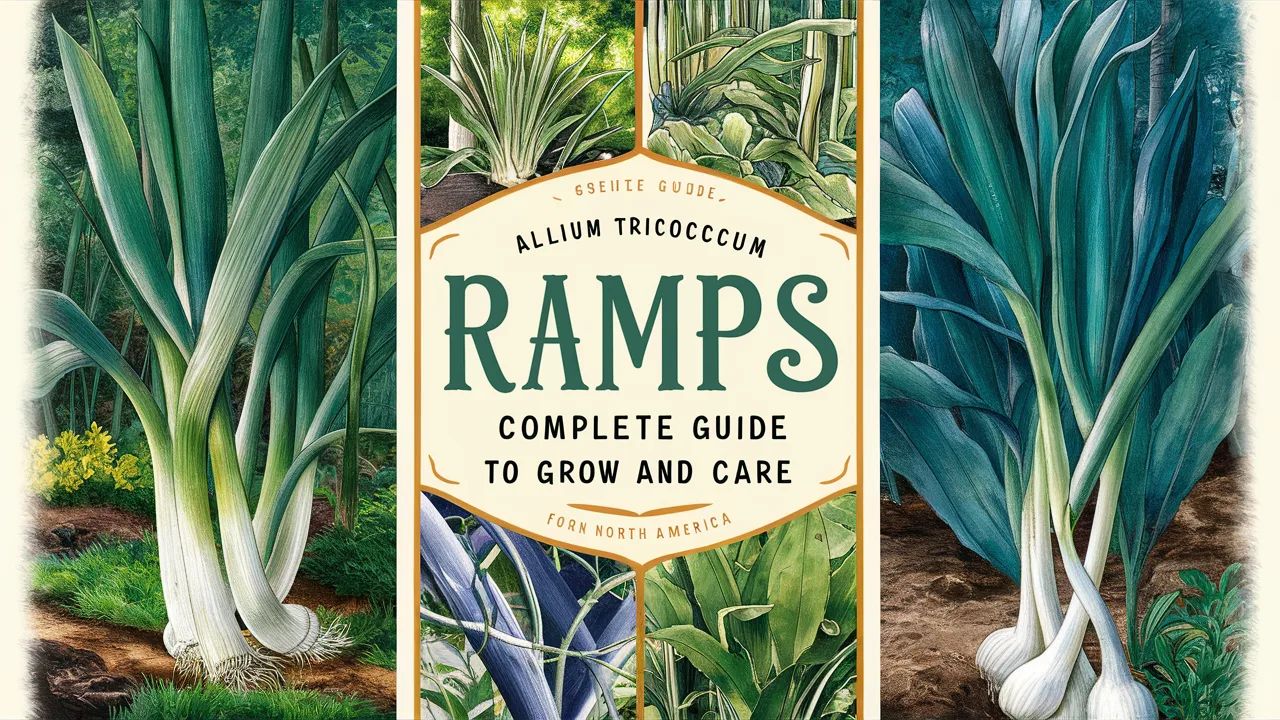Native to eastern North America, ramps (Allium tricoccum), often known as wild leaks, are transitory plants that occur in damp woodlands in the Appalachian Mountain Range. It’s a late spring ephemeral that vanishes in a month or two and goes dormant until the next spring. With pinkish-white blossoms, these tiny, slowly maturing bulbs spread and colonize over time. For seed, it can take up to seven years to yield, while bulbs might take up to three years. Although they can be planted in the fall, seeds, bulbs, and plants are normally started in the spring.
Table of Contents
ToggleRamps Overview

| Common Name | Ramps, wild leeks |
| Botanical Name | Allium tricoccum |
| Family Name | Amaryllidaceae |
| Plant Type | Bulb, perennial |
| Mature Size | 6-12 in. tall, 1-2 ft. wide |
| Flower Color | White |
| Sun Exposure | Shade, partial shade |
| Soil Type | Loamy |
| Soil pH | Neutral |
| Bloom Time | Spring |
| Hardiness Zones | 3-7 (USDA) |
| Native Area | North America |
How to Plant Ramps?

You can plant ramps as seeds or bulbs. The best times to plant depend on the technique you use. Vegetables come from bulbs in half the time.
When to Plant
The main objectives of planting ramps in a home garden are to create the colony for future growth and to gather the aromatic leaves in the spring. Ramps can be sown as seeds in late summer or early fall (August to early October) or as bulbs from September to March (February to mid-March is ideal).
Ramps harvest the early spring’s enhanced daylight and warming temperatures in the wild, when the deciduous trees overhead have not yet dropped their leaves. The ramps fade beneath the little light that reaches the woodland floor as the season goes on and the tree canopies close in. The bulbs grow underground, and in early June the leaves begin to wither, followed by the flower stalks.
Selecting a Planting Site
A ramp colony does best in a cool, forested environment or in a naturalized shade garden with loamy soil. Give the plants plenty of water, then cover the entire bed with leaf mold or shreds of leaves.
Spacing, Depth, and Support
Take extreme caution not to harm the roots or bulbs when beginning with transplants or bulbs. Plant at the same depth as they did in the container, which is around 3 inches deep. To allow the plants to spread, space them 4 to 6 inches apart. Plant the seeds 4 inches apart in the ground, and then cover them with 1 inch of wet leaves.
Ramp Care
Light Requirements
Ramps require protection from the intense heat and sun of summer since they are spring woodland plants. Give them a position in the shade or partially shaded area if you are unable to put them near the edge of a woodland, where they will receive protection when the trees leaf out.
Soil & Potting
Choose a spot in your yard that will grow ramps as closely as possible to their natural growing environment. Usually, they are found beneath deciduous trees in damp places. The soil need to drain well and contain a healthy amount of organic materials. The optimal pH range for the soil is 6.8 to 7.2, which is quite close to neutral.
Watering
Ramps prefer consistent moisture, but they struggle to thrive in soggy soil. Ramps should do well if nearby woodland flowers like bloodroot, trillium, and trout lilies grow. There isn’t much space for error because they only develop aggressively for a short while in the spring.
Temperature and Environment
Ramps should be stored at a temperature of 54 degrees Fahrenheit during the day and 46 degrees at night. Nonetheless, it typically develops at temperatures between 42 and 58 degrees Fahrenheit at night and 45 to 65 degrees Fahrenheit during the day. Ramps are native to the hardwood forests of the northeastern United States. They thrive in a wide range of humidity conditions, from approximately 5% in late January to over 60% by the end of May.
Fertilization
If the soil is neutral in pH and rich in organic materials, ramps might not require any feeding. They like rather high calcium and magnesium soil; if your soil isn’t very good, you might want to feed them these nutrients.
Pollination
In addition to providing an early source of nectar and helping ramps produce berries that fall in the summer, bees and flies pollinate the blooms on the ramps.
Types of Ramps
Allium tricoccum: Typical ramps with enormous bulbs and leaves
Allium burdickii: Hard to find narrow-leafed ramps that are mostly found in the Midwest, eastern Canada, and New England
Allium ursinum: Native to the British Isles and Europe, ramsons are also known as wild garlic, wood garlic, bear leaf, or buckrams. They are somewhat bigger than ramps and closely related to them.
Harvesting
Ramp leaves are oval-shaped in form and taper to a point. Though a little thinner, they resemble the leaves of lilies of the valley. The flower stalk of wild leeks usually appears when the leaves start to wither. Ramps can be harvested whenever you choose, but if you harvest before the patch has had time to grow, it will quickly become exhausted.
Allow the patch to grow for a few years before harvesting it by digging the entire clump, including the bulb, and thinning out the larger plants. Take care not to harm nearby plants.
They taste like a cross between garlic and spring onions. Ramps can be used to spice other meals or eaten on their own and are excellent either way. You can blanch, fry, cut, and include the leaves, stems, and bulbs into recipes.
The maturation of these perennials for harvest is a rather slow process. While plants generated from bulbs or young plants may be ready to harvest in two to three years, plants started from seed may not be harvestable for seven years.
Ramps can be kept in the fridge for up to a week. After cleaning them of any debris, put them in the crisper drawer and cover them loosely with a wet paper towel. To hold onto them for longer: You can dehydrate, pickle, freeze, or blanch them. They can also be ground down into a seasoning powder.
How to Grow Ramps in Pots?

Although shallow raised beds work better, ramps can be grown in pots as well. They require only a foot or so of depth. Ramps will spread out and colonize a container if they are cultivated in pots or raised beds with the right soil, light, water, nutrients, and temperature.
As with a woodland garden, plant seeds and bulbs in the same manner. Plants, seeds, or bulbs should be spaced 4 inches apart. Because ramps dislike damp soil, make sure pots have plenty of drainage holes. Apply a layer of leaf mulch, one to two inches thick, to replicate their natural growing conditions.
What Do Ramps Taste Like?
Ramps taste like a cross between onions and garlic, as their gastronomic relationships would imply. They’ve received the nickname “little stinkers” because some people claim they smell stronger than garlic.
Bennett offers an alternative explanation, saying, “They taste like garlicky leek.”
The green leafy tops of the ramps are softer than the purple or white stems and bulbs, so if you’re not a fan of these strong flavors, boiling the plant will assist.
Pruning
Get rid of any weeds that could rival ramps for nutrients and available space. Additionally, you should deadhead blooms or gather scapes before they turn into berries and seeds that fall to the ground in order to manage the size of your colony and avoid having too many ramps in one place fighting with one another. Harvest the bulbs, roots and all, if your colony is closely spaced to give yourself extra growing room.
Propagating Ramps
Planting bare root bulbs, seeds, and dividing existing colonies are the most effective ways to reproduce ramps. Here’s how to plant bulbs and divide an established colony:
- With a shovel, excavate a cubic square of earth.
- The entire soil plot should be replanted in its new location.
- Alternatively, you can split the bulbs out and plant each one separately, spaced roughly 4 inches apart and 3 inches deep.
How to Grow Ramps From Seed?
The seed is spread in close proximity to the parent plant. Raising ramps from seed can be a laborious process. In a fresh seed, the seed embryo may not fully develop and may stay dormant. For germination, it requires both warm and cold stratification, which means that it must first be warm and wet to break root dormancy and then cold to break shoot dormancy. It may take a few years for the seed to sprout because the weather varies every year. Late summer to early fall is the ideal time of year to plant ramp seeds. How to do it is as follows:
- Press the seed into the top layer of soil by scratching and loosening it.
- Add about 1 inch of wet, shredded leaves on top.
- Two to three years may pass before germination occurs and shoots begin to emerge. Before they are prepared for harvesting, it may take an additional three or four years.
Overwintering
Ramp seed requires specific conditions for both temperature and moisture, thus it can take several seasons for it to sprout. The embryo in ramp seeds is undeveloped and inactive. For the purpose of germination and shoot dormancy, ramps require a winter season. There is no need to cover ramps during the winter.
Common Pests and Plant Diseases
Ramps are ephemerals that spend so little time above ground that they are rarely affected by illness or insects. Although they rarely have an impact on harvest, two pests and diseases to be aware of include Septoria leaf spot and the allium leaf miner fly (Phytomyza gymnostoma). Aphids and caterpillars are also able to cling to vegetation.
Water at ground level and refrain from overhead irrigation to prevent leaf spot. Use a cold water hose to spray your plants to get rid of aphids and caterpillars. To keep allium leaf miners away from your plants, use floating row coverings or think about using insecticidal control techniques.





